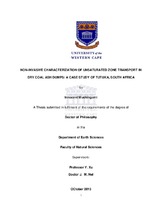| dc.description.abstract | The management of the large volumes of solid wastes produced as coal combustion
residue is of particular concern due to the presence of leachable metals and salts which
may constitute a long term environmental risk and potential contamination of both
surface and groundwater systems of the surrounding environment. In order to
implement an efficient monitoring scheme and to assess the impact of the ash dump on
the hydrologic system, a thorough knowledge on the migration of solutes fluxes in dry
ash dumps as well as the controls on the transport of these solutes to the underlying
groundwater system is required.
The conventional methods which have been widely used for such applications are
centred on extracting and analysing several samples from observation wells are drilled
on the dump. This has however created a potentially hazardous situation as the
installation of monitoring wells may result in the creation of new fluid pathways and
results in further migration of leachates. Nevertheless, non–invasive characterization
has often been useful in the determination of subsurface hydraulic properties and is a
key step towards the solution of real-life problems in hydrology, hydrogeology and soil
science. In contaminant transport non-invasive methods have often proved to be an
efficient tool as compared to traditional drilling and sampling techniques which in most
cases results in the creation of preferential flow paths and do not allow for the space
and time resolution needed for the monitoring of hydrological and environmental
processes.
In this context, this study seeks to develop a generic conceptual model for the ash
dump through the use of non-invasive geophysical techniques and numerical modelling techniques at the Tutuka Ash dump, Mpumalanga South Africa. Changes in electrical
resistivity were used correlate changes in moisture contents during moisture and salt
leachate ingression in ash dumps with a sufficient accuracy. A determination of the
suitability of Archie‘s law to describe the relationship between electrical resistivity and
solute transport ash medium was achieved through empirical laboratory experiments.
Electrical resistivity tomography was then used as an appropriate tool for the elucidation
of potential flow paths and brine dispersion in the ash dump. The flow rates through the
ash dump were estimated by considering the rate of brine injection and the distance
travelled by the brine plume over the time spanned in time lapse infiltration experiments.
Additional geophysical profiles managed to show the lithostratigraphy of underlying
hydro-geology, thereby ensuring that the knowledge of the geology can be established
without the application of any intrusive methods.
To ensure that development of the conceptual model of the unsaturated zone transport
of the ash dump was developed with sufficient accuracy, numerical models were also
used to describe solute transport in the vadose zone. The HYDRUS2D numerical
package was used simulate the flux dynamics within the unsaturated zone of the coal
ash medium, so as to develop a conceptual understanding of water flow and salt
transport through the unsaturated zone of the coal ash medium. The results from the
study suggested a conceptual solute transport model that consists of a two layers. The
upper layer represented the unsaturated zone of the ash dump which was the source of
any potential contaminant transport that could be of concern. The lower layer describe
the underlying the subsurface environment to the ash dump which include the soil zone,
the shallow aquifer and the deep fractured rock aquifer. To enable this conceptualisation, results from the numerical simulations and
geophysical interpretations of the electrical resistivity profiles were the critical
components for optimising the site-specific subsurface water flow and solute transport
processes, as well as producing the most acceptable conceptualisation of the ash dump
system that could be used in hazard assessment and mitigation against potential
groundwater pollution. The conceptual models developed in this study proposed an
explanation on impact of the ash dump to the hydro-geologic and the eco-hydrologic
environment by proposing a scenario of contamination of the underling ash dump and
the existing. In this regard, the study managed to provide important scenarios that may
be necessary during mitigation procedures for both the ash dump and the wetland.
Key words: non-invasive, coal ash, time lapse, electrical resistivity tomography,
numerical models, HYDRUS2D, conceptual model. | en_US |

